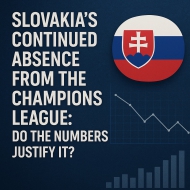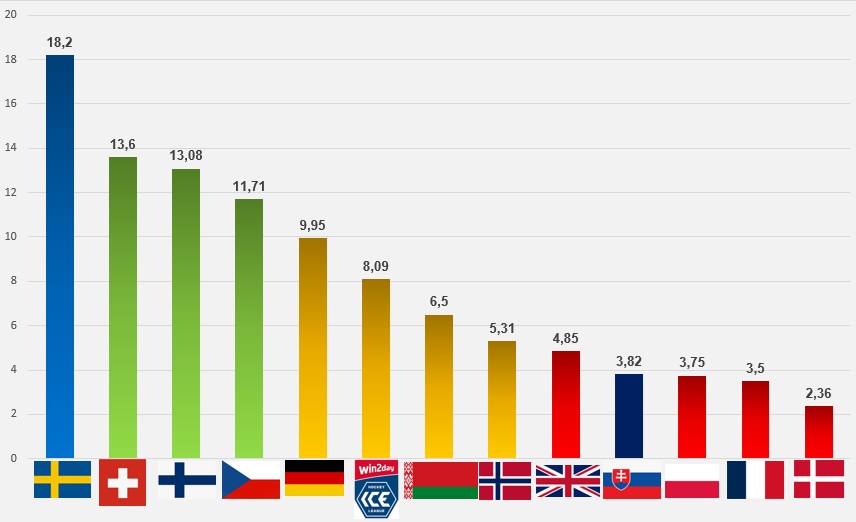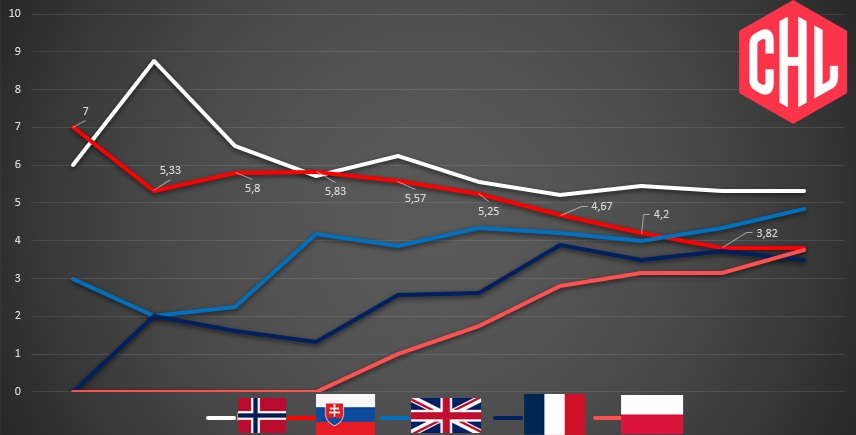EIHL defenceman reaches milestone
Mark Richardson (Cardiff Devils, EIHL) surpassed Jonathan Phillips' all-time record for games played in the Elite League on Sunday night, playing in his 1,178th EIHL game. ... Read more»

Despite a proud hockey tradition, Slovak teams are out of Europe’s elite league. The numbers explain why.
In five weeks, the 11th season of the Hockey Champions League will begin—a European competition for the top clubs from individual countries, following on from the former European Trophy project
Intended as the hockey counterpart to football’s UEFA Champions League, the competition continues to struggle with its appeal. The main issues are its early start—often during clubs' pre-season training—and its long-standing lack of financial incentives. As a result, organizers have continuously tried to enhance its attractiveness by changing formats and reducing the number of participating teams. Compared to the 2016/17 season, which featured 48 teams, the current format includes only 24 teams for the third year in a row.
Each team plays six games, and all points are recorded in a single table. The top 16 teams advance to the knockout stage. However, the reduced number of teams has also affected Slovakia, which will go unrepresented in the Champions League for the second consecutive year.
But is the absence of Slovak teams justified? And which countries have historically performed the best? To answer these questions, we’ll examine specific statistics—namely, the average number of points earned per team throughout the competition’s history.
Example: In the 2024/25 season, Swedish teams earned a combined 58 points in the regular season and playoffs. Since Sweden was represented by three teams, the average was 19.33 points per team. This "points per team" metric is the fairest way to assess overall quality, as the number of teams per country has varied due to format changes.
Typically, about two-thirds of the teams advance to the playoffs

As the statistics show, Sweden is clearly the most successful nation in Champions League history. Not only does it boast the most titles (six, compared to two each for Finland and Switzerland), but Swedish teams consistently deliver top performances, averaging over 18 points per team—equivalent to more than six wins per team.
Teams from Switzerland, Finland, and the Czech Republic have also performed at a high level, while Germany and the multinational ICEHL have fared slightly worse. Though clubs from Ukraine and Slovenia have participated, they were excluded from the rankings due to their limited sample size (only one team each).
Given these statistics, many fans may feel that Slovak clubs were unfairly excluded in favor of Poland, France, or especially Denmark—countries with historically weaker results

This more recent comparison paints a stark picture for Slovak hockey fans. Averaging less than one point per team over the past five years is a harsh reality—and one that supports the decision to exclude Slovak teams from the competition in favor of Danish clubs.
Slovakia’s last Champions League points were earned before the COVID-19 pandemic. Since then, Slovan Bratislava has failed twice, and Košice once, to score even a single point. While this statistic doesn’t capture the full picture of league quality, it reflects poorly on Slovakia's standing in European hockey, particularly given that Polish and Danish teams have outperformed them recently. Moreover, Slovak teams have often faced criticism for their lackluster approach to the competition.
The data also reveal a compelling trend: over the past five years, Sweden has become even more dominant, and Switzerland has reached an impressive 15-point average. Germany has surged into third place—perhaps unexpectedly—while Finland has seen a slow decline from the top.
When Did Slovakia’s Decline Begin?Many fans still remember successful campaigns by Košice and Nitra, both of which reached the knockout stage. Košice even won a playoff match against Sweden’s Skellefteå AIK, while Nitra earned nine points in the group stage against Norwegian Stavanger and Czech side Plzeň.
So when did the downturn begin? To answer that, let’s look at how each country’s points-per-team average has evolved throughout the competition’s history

In the early years, Slovakia was one of the better-performing nations among those with only one or two representatives per season. As of the 2017/18 season, Slovakia had the highest average at 5.83 points per team. However, since 2019/20, Slovakia has stagnated and declined, while its closest competitors—such as Norway, Great Britain, France, and especially Poland—have either maintained stable results or improved.
Denmark, which historically lagged behind Slovakia, has also posted better numbers over the last five seasons. If Slovak clubs return to the competition in the future, it would likely come at the expense of the Danish champion.
 Andrej Sustr
(D)
Andrej Sustr
(D)
 Bridgeport Islanders
Bridgeport Islanders Jakub Ižacký
(F)
Jakub Ižacký
(F)
 HC Amiens Somme
HC Amiens Somme HC Frýdek-Místek
HC Frýdek-Místek Lukáš Kovář
(D)
Lukáš Kovář
(D)
 Mountfield HK
Mountfield HK HC Frýdek-Místek
HC Frýdek-Místek Brendan O’Donnell
(F)
Brendan O’Donnell
(F)
 HC Kometa Group
HC Kometa Group Adler Mannheim
Adler Mannheim Colin Smith
(F)
Colin Smith
(F)
 EC Kassel Huskies
EC Kassel Huskies HC Vita Hästen
HC Vita Hästen Alex Jaakkola
(F)
Alex Jaakkola
(F)
 Grums IK
Grums IK Kongsvinger IL
Kongsvinger IL Victor Björkung
(D)
Victor Björkung
(D)
 Marseille Spartiates
Marseille Spartiates HK Zagłębie Sosnowiec
HK Zagłębie Sosnowiec
 Czech Rep.:
Tipsport extraliga |
1.liga |
2.liga
Czech Rep.:
Tipsport extraliga |
1.liga |
2.liga
 Slovakia:
Tipsport Extraliga |
1.liga
Slovakia:
Tipsport Extraliga |
1.liga
 Sweden:
SHL |
HockeyAllsvenskan
Sweden:
SHL |
HockeyAllsvenskan
Other: EBEL | Belarus | Croatia | Denmark | Estonia | France | Great Britain | Iceland | Italy | Latvia | Lithuania | MOL-liga | Norway | Poland | Romania | Serbia | Slovenia | Spain | NHL | AHL |
Mark Richardson (Cardiff Devils, EIHL) surpassed Jonathan Phillips' all-time record for games played in the Elite League on Sunday night, playing in his 1,178th EIHL game. ... Read more»
Cortina battles back from behind in a nail-biting contest, yet the victory cannot change their fate in the Continental Cup Read more»